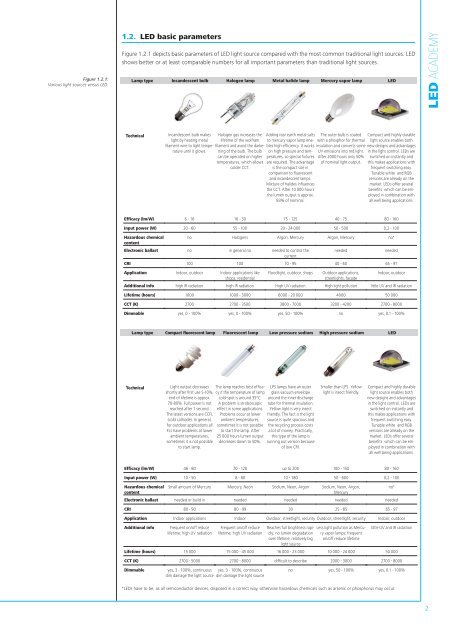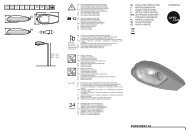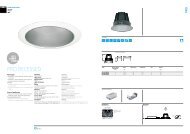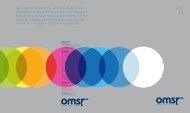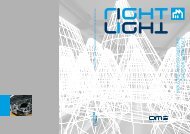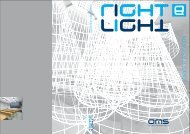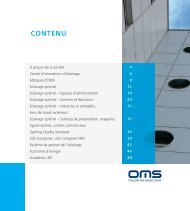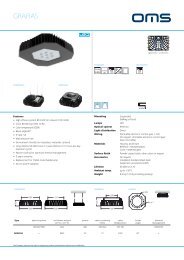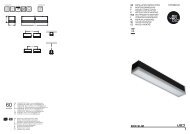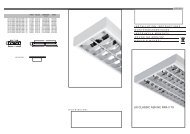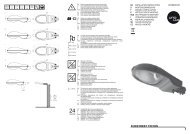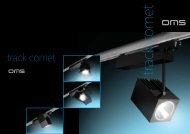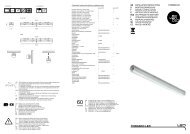Create successful ePaper yourself
Turn your PDF publications into a flip-book with our unique Google optimized e-Paper software.
Figure 1.2.1:Various light sources versus <strong>LED</strong>.1.2. <strong>LED</strong> basic parametersFigure 1.2.1 depicts basic parameters of <strong>LED</strong> light source compared with the most common traditional light sources. <strong>LED</strong>shows better or at least comparable numbers for all important parameters than traditional light sources.Lamp type Incandescent bulb Halogen lamp Metal halide lamp Mercury vapor lamp <strong>LED</strong><strong>LED</strong> <strong>ACADEMY</strong>TechnicalIncandescent bulb makeslight <strong>by</strong> heating metalfilament wire to light temperatureuntil it glows.Halogen gas increases thelifetime of the wolframfilament and avoid the darkeningof the bulb. The bulbcan be operated on highertemperatures, which allowscolder CCT.Adding rear earth metal saltsto mercury vapor lamp enableshigh efficiency. It workson high pressure and temperatures,so special fixturesare required. The advantageis the compact size incomparison to fluorescentand incandescent lamps.Mixture of halides influencesthe CCT. After 10 000 hoursthe lumen output is approx.83% of nominal.The outer bulb is coatedwith a phosphor for thermalinsulation and converts someUV emissions into red light.After 2000 hours only 50%of nominal light output.Compact and highly durablelight source enables bothnew designs and advantagesin the light control. <strong>LED</strong>s areswitched on instantly andthis makes applications withfrequent switching easy.Tunable white and RGBversions are already on themarket. <strong>LED</strong>s offer severalbenefits which can be employedin combination withall well being applications.Efficacy (lm/W) 6 - 16 16 - 30 75 - 125 40 - 75 80 - 160Input power (W) 20 - 60 55 - 100 20 - 24 000 50 - 500 0,2 - 100Hazardous chemicalcontentno Halogens Argon, Mercury Argon, Mercury no*Electronic ballast no in general no needed to control thecurrentCRI 100 100 70 - 95 40 - 60 65 - 97Application Indoor, outdoor Indoor applications likeshops, residentialFloodlight, outdoor, shopsneededOutdoor applications,streetlights, facadeneededIndoor, outdoorAdditional info high IR radiation high IR radiation High UV radiation High light pollution little UV and IR radiationLifetime (hours) 1000 1000 - 3000 6000 - 20 000 4000 50 000CCT (K) 2700 2700 - 3500 3800 - 7000 3200 - 4200 2700 - 8000Dimmable yes, 0 - 100% yes, 0 - 100% yes, 50 - 100% no yes, 0.1 - 100%Lamp type Compact fluorescent lamp Fluorescent lamp Low pressure sodium High pressure sodium <strong>LED</strong>TechnicalLight output decreasesshortly after first use 5-10%,end of lifetime is approx.70-80%. Full power is notreached after 1 second.The latest versions are CCFL(cold cathode). In general,for outdoor applications allFLs have problems at lowerambient temperatures,sometimes it is not possibleto start lamp.The lamp reaches best efficacyif the temperature of lampcold-spot is around 35°C.A problem is stroboscopiceffect in some applications.Problems occur at lowerambient temperatures,sometimes it is not possibleto start the lamp. After25 000 hours lumen outputdecreases down to 50%.LPS lamps have an outerglass vacuum envelopearound the inner dischargetube for thermal insulation.Yellow light is very insectfriendly. The fact is the lightsource is quite spacious andthe recycling process costsa lot of money. Practically,this type of the lamp isrunning out version becauseof low CRI.Smaller than LPS. Yellowlight is insect friendly.Compact and highly durablelight source enables bothnew designs and advantagesin the light control. <strong>LED</strong>s areswitched on instantly andthis makes applications withfrequent switching easy.Tunable white and RGBversions are already on themarket. <strong>LED</strong>s offer severalbenefits which can be employedin combination withall well being applications.Efficacy (lm/W) 46 - 80 70 - 120 up to 200 100 - 150 80 - 160Input power (W) 10 - 50 8 - 80 10 - 180 50 - 600 0,2 - 100Hazardous chemicalcontentSmall amount of Mercury Mercury, Neon Sodium, Neon, Argon Sodium, Neon, Argon,MercuryElectronic ballast needed or build in needed needed needed neededCRI 80 - 90 80 - 99 30 25 - 85 65 - 97Application Indoor applications Indoor Outdoor, streetlight, security Outdoor, streetlight, security Indoor, outdoorAdditional infoFrequent on/off reducelifetime; high UV radiationFrequent on/off reducelifetime; high UV radiationReaches full brightness rapidly;no lumen degradationover lifetime; relatively biglight sourceLess light pollution as Mercuryvapor lamps; frequenton/off reduce lifetimeno*little UV and IR radiationLifetime (hours) 15 000 15 000 - 45 000 16 000 - 23 000 10 000 - 24 000 50 000CCT (K) 2700 - 5000 2700 - 8000 difficult to describe 2000 - 3000 2700 - 8000Dimmableyes, 3 - 100%, continuous yes, 3 - 100%, continuousdim damage the light source dim damage the light sourceno yes, 50 - 100% yes, 0.1 - 100%*<strong>LED</strong>s have to be, as all semiconductor devices, disposed in a correct way, otherwise hazardous chemicals such as arsenic or phosphorus may occur.2


